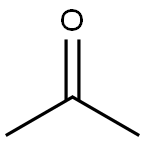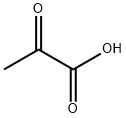Acetone , natural,≥97% , 67-64-1
Synonym(s):
Dimethyl Ketone, 2-Propanone;Dimethyl ketone, Propanone, 2-Propanone
CAS NO.:67-64-1
Empirical Formula: C3H6O
Molecular Weight: 58.08
MDL number: MFCD00211536
EINECS: 200-662-2
PRODUCT Properties
| Melting point: | -94 °C(lit.) |
| Boiling point: | 56 °C760 mm Hg(lit.) |
| Density | 0.791 g/mL at 25 °C(lit.) |
| vapor density | 2 (vs air) |
| vapor pressure | 184 mm Hg ( 20 °C) |
| FEMA | 3326 | ACETONE |
| refractive index | n |
| Flash point: | 1 °F |
| storage temp. | Store at +5°C to +30°C. |
| solubility | Miscible with water and with ethanol (96 per cent). |
| pka | 19.3(at 25℃) |
| form | Liquid |
| Specific Gravity | 0.79 (25/25℃) |
| color | Colorless, invisible vapor |
| Odor | Characteristic pungent odor detectable at 33 to 700 ppm (mean = 130 ppm) |
| PH | 5-6 (395g/l, H2O, 20°C) |
| Relative polarity | 0.355 |
| Odor Threshold | 42ppm |
| explosive limit | 2.6-12.8%(V) |
| Odor Type | solvent |
| biological source | synthetic |
| Water Solubility | soluble |
| λmax | ≤330 nm |
| JECFA Number | 139 |
| Merck | 14,66 |
| BRN | 63580 |
| Henry's Law Constant | 2.27 at 14.9 °C, 3.03 at 25 °C, 7.69 at 35.1 °C, 11.76 at 44.9 °C (Betterton, 1991) |
| Exposure limits | TLV-TWA 1780 mg/m3 (750 ppm), STEL
2375 mg/m3 (ACGIH); 10 h–TWA 590
mg/m3 (250 ppm); IDLH 20,000 ppm
(NIOSH). |
| Dielectric constant | 1.0(0℃) |
| LogP | -0.160 |
| Surface tension | 23.02mN/m at 298.15K |
| Surface tension | 25.2mN/m at 20°C |
| CAS DataBase Reference | 67-64-1(CAS DataBase Reference) |
| NIST Chemistry Reference | Acetone(67-64-1) |
| EPA Substance Registry System | Acetone (67-64-1) |
Description and Uses
Acetone is a flammable, colorless liquid with a pleasant odor. It is used widely as an organic solvent and in the chemical industry. It is the simplest ketone, which also goes by the name dimethyl ketone (DMK). Acetone was originally referred to as pyroacetic spirit because it was obtained from the destructive distillation of acetates and acetic acid.
Acetone is used in the chemical industry in numerous applications. The primary use of acetone is to produce acetone cyanohydrin, which is then used in the production of methyl methacrylate (MMA). Another use of acetone in the chemical industry is for bisphenol A (BPA). BPA results form the condensation reaction of acetone and phenol in the presence of an appropriate catalyst. BPA is used in polycarbonate plastics, polyurethanes, and epoxy resins. Polycarbonate plastics are tough and durable and are often used as a glass substitute.
In addition to its use as a chemical feedstock and intermediate, acetone is used extensively as an organic solvent in lacquers, varnishes, pharmaceuticals, and cosmetics. Nail polish remover is one of the most common products containing acetone. Acetone is used to stabilize acetylene for transport .
Safety
| Symbol(GHS) |   GHS02,GHS07 |
| Signal word | Danger |
| Hazard statements | H225-H319-H336 |
| Precautionary statements | P210-P233-P240-P241-P242-P305+P351+P338 |
| Hazard Codes | F,Xi,T |
| Risk Statements | 11-36-66-67-39/23/24/25-23/24/25 |
| Safety Statements | 9-16-26-45-36/37-7 |
| RIDADR | UN 1090 3/PG 2 |
| OEB | A |
| OEL | TWA: 250 ppm (590 mg/m3) |
| WGK Germany | 3 |
| RTECS | AL3150000 |
| F | 3-10 |
| Autoignition Temperature | 465 °C |
| TSCA | Yes |
| HazardClass | 3 |
| PackingGroup | II |
| HS Code | 29141100 |
| Hazardous Substances Data | 67-64-1(Hazardous Substances Data) |
| Toxicity | LD50 in rats: 10.7 ml/kg orally (Smyth) |
| IDLA | 2,500 ppm |



